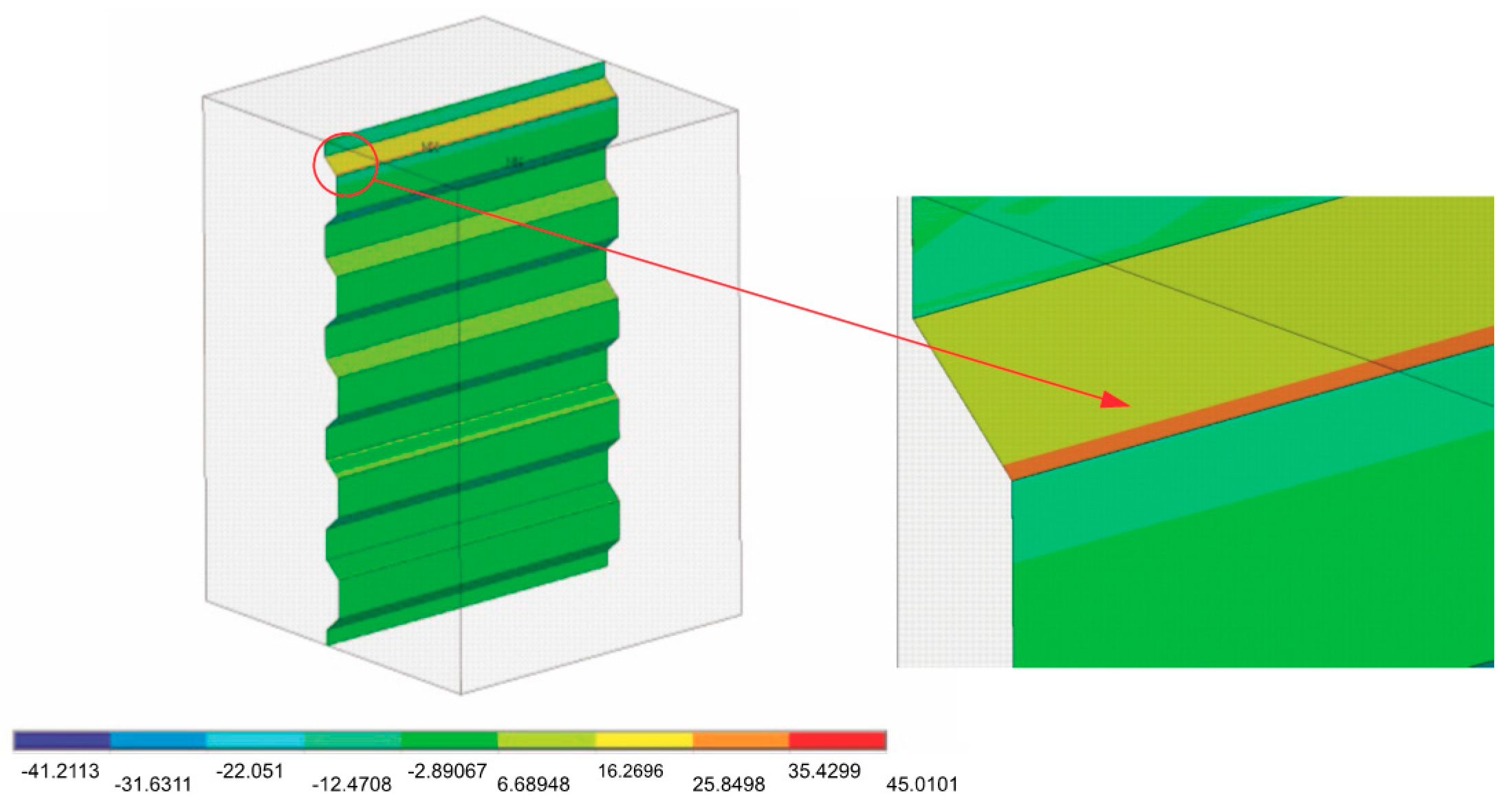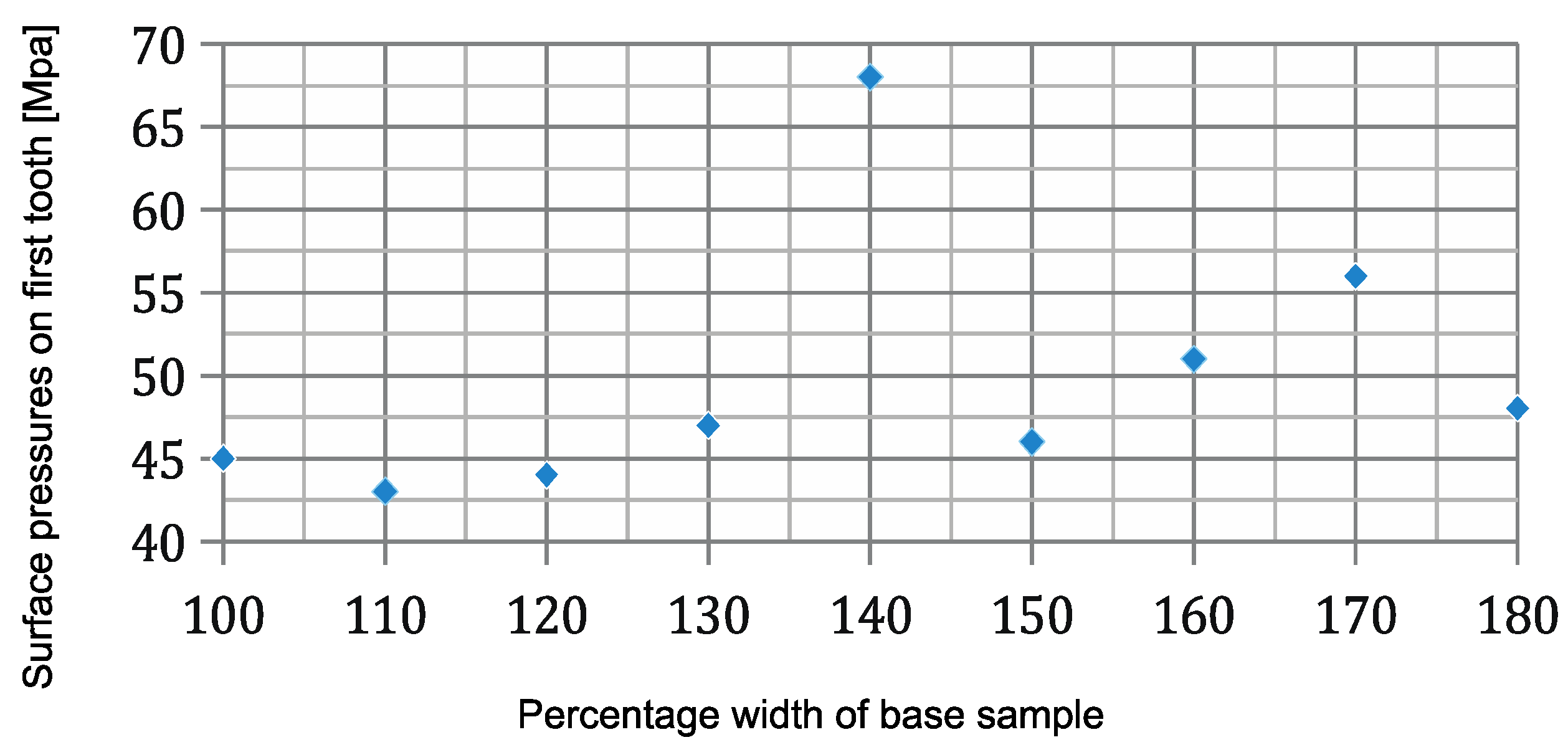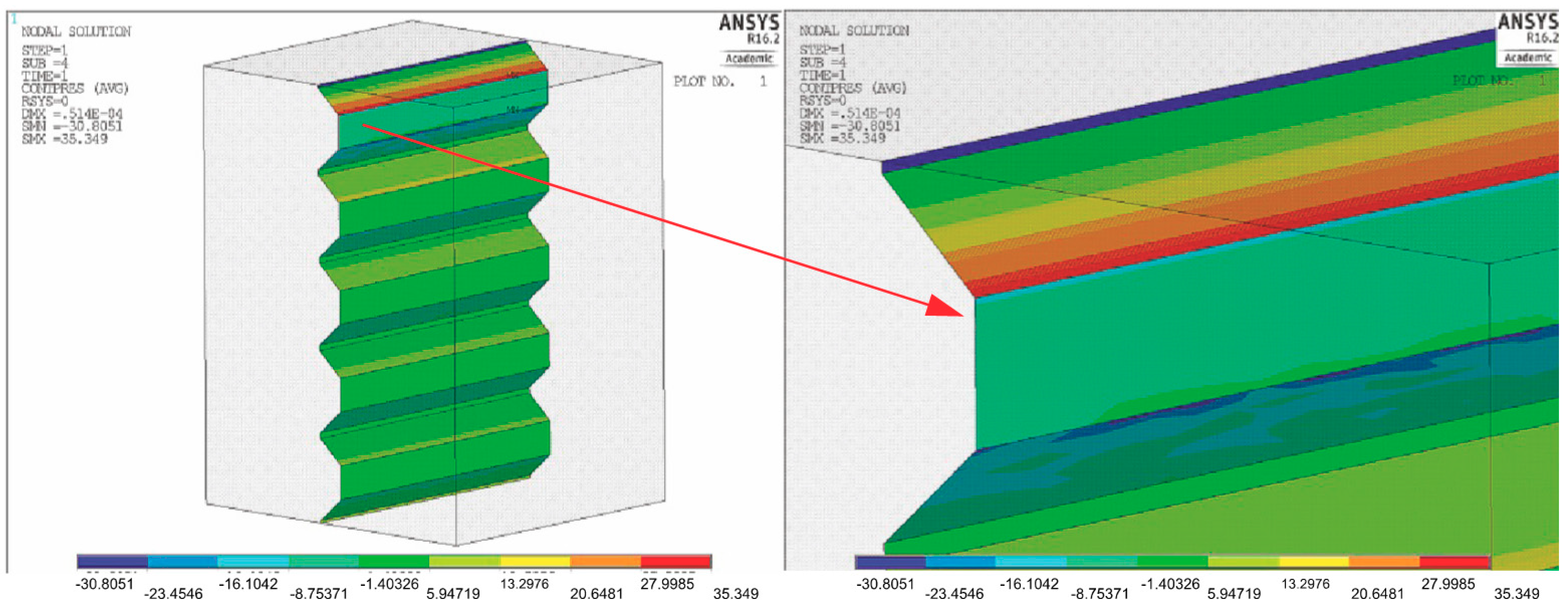The Use of the FEM to Identify the Optimal Groove Dimensions Ensuring the Least Stressed Connection between a Zirconia Coping and Veneering Ceramic
Abstract
:1. Introduction
2. Material and Methods
3. Results
4. Discussion
5. Conclusions
- The originally proposed nominal notch dimensions have been shown to be suitable due to the strain level in the connection.
- An increase in groove depth, with the other geometrical dimensions remaining constant, enables a reduction in the connection strain.
- A simultaneous 40% increase in the width and a 40% increase in depth does not significantly reduce the connection strain.
- This analysis may be useful when selecting the correct laser light beam parameters for zirconium surface conditioning.
Author Contributions
Conflicts of Interest
References
- Baldissara, P.; Llukacej, A.; Ciocca, L.; Valandro, F.L.; Scotti, R. Translucency of zirconia copings made with different CAD/CAM systems. J. Prosthet. Dent. 2010, 104, 6–12. [Google Scholar] [CrossRef]
- Grenade, C.; Mainjot, A.; Vanheusden, A. Fit of single tooth zirconia copings: Comparison between various manufacturing processes. J. Prosthet. Dent. 2011, 105, 249–255. [Google Scholar] [CrossRef]
- Eichler, A. Tetragonal Y-doped zirconia: Structure and ion conductivity. Phys. Rev. B 2001, 64, 174103. [Google Scholar] [CrossRef]
- Coelho, P.G.; Silva, N.R.; Boufante, E.A.; Guess, P.C.; Rekow, E.D.; Thompson, V.P. Fatigue testing of two porcelain-zirconia all-ceramic crown systems. Dent. Mater. 2009, 25, 1122–1127. [Google Scholar] [CrossRef] [PubMed]
- Studart, A.R.; Filser, F.; Kocher, P.; Lüthy, H.; Gauckler, L.J. Cyclic fatigue in water of veneer-framework composites for all-ceramic dental bridges. Dent. Mater. 2007, 23, 177–185. [Google Scholar] [CrossRef] [PubMed]
- Wang, F.; Takahashi, H.; Iwasaki, N. Translucency of dental ceramics with different thicknesses. J. Prosthet. Dent. 2013, 110, 14–20. [Google Scholar] [CrossRef]
- Beuer, F.; Stimmelmayrb, M.; Guetha, F.; Edelhoffa, D.; Naumannc, M. In vitro performance of full-contour zirconia single crowns. Dent. Mater. 2012, 28, 449–456. [Google Scholar] [CrossRef] [PubMed]
- Benetti, P.; Pelogia, F.; Valandro, L.F.; Bottino, M.A.; Bona, A.D. The effect of porcelain thickness and surface liner application on the fracture behavior of a ceramic system. Dent. Mater. 2011, 27, 948–953. [Google Scholar] [CrossRef] [PubMed]
- Sailer, I.; Feher, A.; Filser, F.; Gauckler, L.J.; Luthy, H.; Hammerle, C.H. Five-year clinical results of zirconia frameworks for posterior fixed partial dentures. Int. J. Prosthodont. 2007, 20, 383–388. [Google Scholar] [PubMed]
- Plengsombut, K.; Brewer, J.D.; Monaco, E.A.; Davis, E. Effect of two connector designs on the fracture resistance of all-ceramic core materials for fixed dental prostheses. J. Prosthet. Dent. 2009, 101, 166–173. [Google Scholar] [CrossRef]
- Möllers, K.; Pätzold, W.; Parkot, D.; Kirsten, A.; Güth, J.F.; Edelhoff, D.; Fischer, H. Influence of connector design and material composition and veenering on the stress distribution off all-ceramic fixed dental prostheses: A finite element study. Dent. Mater. 2011, 27, 171–175. [Google Scholar]
- Tada, K.; Sato, T.; Yoshinari, M. Infulence of surface treatment on bond strength of veneering ceramics fused to zirconia. Dent. Mater. J. 2012, 31, 287–296. [Google Scholar] [CrossRef] [PubMed]
- Fischer, J.; Stawarczyk, B.; Tomic, M.; Strub, J.R.; Hammerle, C.H.F. Effect of thermal mistif between different veneering ceramics and zirconia frameworks on in vitro fracture load of single crowns. Dent. Mater. J. 2007, 26, 766–772. [Google Scholar] [CrossRef] [PubMed]
- Aboushelib, M.N.; Kleverlaan, C.J.; Feilzer, A.J. Effect of zirconia type on its bond strength with different veneer ceramics. J. Prosthodont. 2008, 17, 401–408. [Google Scholar] [CrossRef] [PubMed]
- Al-Shehri, S.A.; Mohammed, H.; Wilson, C.A. Influence of lamination on the flexural strength of a dental castable glass ceramic. J. Prosthet. Dent. 1996, 76, 23–28. [Google Scholar] [CrossRef]
- Burke, F.J.T.; Crisp, R.J.; Cowan, A.J.; Lamb, J.; Thompson, O.; Tulloch, N. Five-year clinical evaluation of zirconia-based bridges in patients in UK general dental practices. J. Dent. 2013, 41, 992–999. [Google Scholar] [CrossRef] [PubMed]
- Crisp, R.J.; Cowan, A.J.; Lamb, J.; Thompson, O.; Tulloch, N.; Burke, F.J.T. A clinical evaluation of all-ceramic bridges placed in patients attending UK general dental practices: Three-year results. Dent. Mater. 2012, 28, 229–236. [Google Scholar] [CrossRef] [PubMed]
- Denry, I.; Kelly, J.R. State of the art of zirconia for dental applications. Dent. Mater. 2008, 24, 299–307. [Google Scholar] [CrossRef] [PubMed]
- Inokoshi, M.; Yoshihara, K.; Nagaoka, N.; Nakanishi, M.; De Munck, J.; Minakuchi, S.; Vanmeensel, K.; Zhang, F.; Yoshida, Y.; Vleugels, J.; et al. Structural and chemical analysis of the zirconia-veneering ceramic interface. J. Dent. Res. 2016, 95, 102–109. [Google Scholar] [CrossRef] [PubMed]
- De Jager, N.; Pallav, P.; Feilzer, A.J. The influence of design parameters on the FEA- determined stress distribution in CAD CAM produced all-ceramic dental crowns. Dent. Mater. 2005, 21, 242–251. [Google Scholar] [CrossRef] [PubMed]
- Isgrò, G.; Pallav, P.; van der Zel, J.M.; Feilzer, A.J. The influence of the veneering porcelain and different surface treatments on the biaxial flexural strength of a heat-pressed ceramic. J. Prosthet. Dent. 2003, 90, 465–473. [Google Scholar]
- Śmielak, B.; Klimek, L. Effect of hydrofluoric acid concentration and etching duration on select surface roughness parameters for zirconia. J. Prosthet. Dent. 2015, 113, 596–602. [Google Scholar] [CrossRef] [PubMed]
- Curtis, A.R.; Wrigth, A.J.; Fleming, G.J. The influence of surface modification techniques on the performance of a Y-TPZ dental ceramic. J. Dent. 2006, 34, 195–206. [Google Scholar] [CrossRef] [PubMed]
- Kumbuloglu, O.; Lassila, L.V.; User, A.; Vallittu, P.K. Bonding of resin composite luting cements to zirconium oxide by two air-particle abrasion methods. Oper. Dent. 2006, 31, 248–255. [Google Scholar] [CrossRef] [PubMed]
- Studart, A.R.; Filser, F.; Kocher, P.; Gauckler, L.J. Fatigue of zirconia under cyclic loading in water and its implications for the design of dental bridges. Dent. Mater. 2007, 23, 106–114. [Google Scholar] [CrossRef] [PubMed]
- Kosmac, T.; Oblak, C.; Jevnikar, P.; Funduk, N.; Marion, L. Strength and reliability of surface treated Y-TZP dental ceramics. J. Biomed. Mater. Res. 2000, 53, 304–313. [Google Scholar] [CrossRef]
- Deville, S.; Chevalier, J.; Gremillard, L. Influence of surface finish and residual stresses on the ageing sensitivity of biomedical grade zirconia. Biomaterials 2006, 27, 2186–2192. [Google Scholar] [CrossRef] [PubMed] [Green Version]
- Bhat, M.A. Lasers in Prosthodontics—An overview Part 1: Fundamentals of Dental Lasers. J. Indian Prosthodont. Soc. 2010, 10, 13–26. [Google Scholar] [CrossRef] [PubMed]
- Ural, Ç.; Külünk, T.; Külünk, Ş.; Kurt, M. The effect of laser treatment on bonding between zirconia ceramic surface and resin cement. Acta Odontol. Scand. 2010, 68, 354–359. [Google Scholar] [CrossRef] [PubMed]
- Armani, S.; Tabatabase, M.H.; Namdar, S.F.; Chiniforush, N. Effect of different lasers and particle abrasion on surface characteristics of zirconia ceramics. J. Dent. 2014, 11, 233–241. [Google Scholar]
- Ersu, B.; Yuzugullu, B.; Yazici, A.R.; Canay, S. Surface roughness and bond strength of glass-infiltrated alumina-ceramics prepared using various surface treatments. J. Dent. 2009, 37, 848–856. [Google Scholar] [CrossRef] [PubMed]
- Hao, L.; Lawrence, J. Effects of Nd:YAG laser treatment on the wettability characteristics of a zirconia-based bioceramic. Opt. Lasers Eng. 2006, 44, 803–814. [Google Scholar] [CrossRef]
- Nicolas, G.; Autric, M.; Marine, W.; Shafeev, G.A. Laser induced surface modifications on ZrO2 ceramics. Appl. Surf. Sci. 1997, 109–110, 289–292. [Google Scholar] [CrossRef]
- Magne, P.; Perakis, N.; Belser, U.; Krejci, I. Stress distribution of inlay-anchored adhesive fixed partial dentures. A finite element analysis of influence of restorative materials and abutment preparation design. J. Prosthet. Dent. 2002, 87, 516–527. [Google Scholar] [CrossRef] [PubMed]
- Farah, J.W.; Craig, R.G.; Meroueh, K.A. Finite element analysis of three- and four-unit bridges. J. Oral Rehabil. 1989, 16, 603–611. [Google Scholar] [CrossRef] [PubMed]
- Bramanti, E.; Cervino, G.; Lauritano, F.; Fiorillo, L.; D’Amico, C.; Sambataro, S.; Denaro, D.; Famà, F.; Ierardo, G.; Polimeni, A.; et al. FEM and Von Mises Analysis on Prosthetic Crowns Structural Elements: Evaluation of Different Applied Materials. Sci. World J. 2017, 1029574. [Google Scholar] [CrossRef] [PubMed]
- Cicciù, M.; Cervino, G.; Milone, D.; Risitano, G. FEM Investigation of the Stress Distribution over Mandibular Bone Due to Screwed Overdenture Positioned on Dental Implants. Materials 2018, 11, 1512. [Google Scholar] [CrossRef] [PubMed]
- Cicciù, M.; Cervino, G.; Bramanti, E.; Lauritano, F.; Lo Gudice, G.; Scappaticci, L.; Rapparini, A.; Guglielmino, E.; Risitano, G. FEM Analysis of Mandibular Prosthetic Overdenture Supported by Dental Implants: Evaluation of Different Retention Methods. Comput. Math. Methods Med. 2015, 2015, 943839. [Google Scholar] [CrossRef] [PubMed]
- Cervino, G.; Romeo, U.; Lauritano, F.; Bramanti, E.; Fiorillo, L.; D’Amico, C.; Milone, D.; Laino, L.; Campolongo, F.; Rapisarda, S.; et al. Fem and Von Mises Analysis of OSSTEM ® Dental Implant Structural Components: Evaluation of Different Direction Dynamic Loads. Open Dent. J. 2018, 12, 219–229. [Google Scholar] [CrossRef] [PubMed]
- Orr, J.F.; Mitchell, C.A. The evaluation of post-retained crowns using a custom-designed fatigue machine. J. Oral Rehabil. 1996, 23, 179–185. [Google Scholar] [CrossRef] [PubMed]
- Mitchell, C.A.; Kennedy, J.G. A semi-empirical model for prediction of how post-retained crowns will fail under compressive loading. J. Dent. Res. 1992, 71, 1613–1618. [Google Scholar] [CrossRef] [PubMed]








| Measurement | A | B | C | D | E | F | G |
|---|---|---|---|---|---|---|---|
| Value (mm) | 0.017 | 0.115 | 0.075 | 0.03 | 0.42 | 0.4 | 0.575 |
| Material | Young’s Modulus | Poisson Number |
|---|---|---|
| Zirconia | 205 GPa | 0.16 |
| Ceramic | 70 GPa | 0.19 |
© 2018 by the authors. Licensee MDPI, Basel, Switzerland. This article is an open access article distributed under the terms and conditions of the Creative Commons Attribution (CC BY) license (http://creativecommons.org/licenses/by/4.0/).
Share and Cite
Śmielak, B.; Klimek, L.; Świniarski, J. The Use of the FEM to Identify the Optimal Groove Dimensions Ensuring the Least Stressed Connection between a Zirconia Coping and Veneering Ceramic. Materials 2018, 11, 2360. https://doi.org/10.3390/ma11122360
Śmielak B, Klimek L, Świniarski J. The Use of the FEM to Identify the Optimal Groove Dimensions Ensuring the Least Stressed Connection between a Zirconia Coping and Veneering Ceramic. Materials. 2018; 11(12):2360. https://doi.org/10.3390/ma11122360
Chicago/Turabian StyleŚmielak, Beata, Leszek Klimek, and Jacek Świniarski. 2018. "The Use of the FEM to Identify the Optimal Groove Dimensions Ensuring the Least Stressed Connection between a Zirconia Coping and Veneering Ceramic" Materials 11, no. 12: 2360. https://doi.org/10.3390/ma11122360






